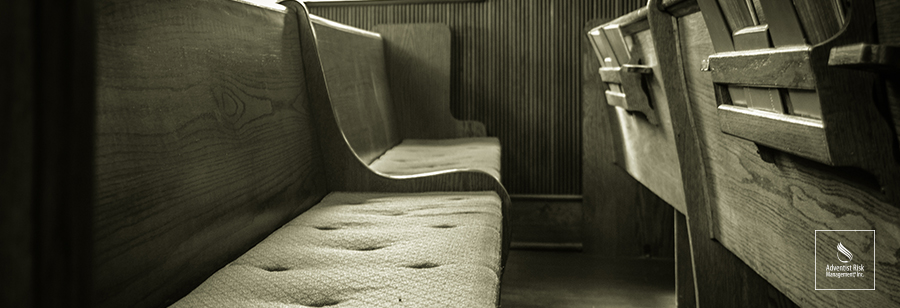A lone grape on a tile floor after potluck, an uneven sidewalk, an unlit stairwell, or loose handrails can all lead to trips and falls. Exit doors blocked by furniture and debris prevent prompt and efficient evacuation during an emergency. These are examples of hazards that frequently occur at our churches and pose a threat to increasing injury and claims severity.
Our members and visitors trust and have the expectation that the church property we own and manage is well maintained and safe. When they come to our churches, we want them to know that they are safe. If the safety of the public is not properly addressed, the church can be held responsible. We must be proactive risk managers and make the safety of all church members a priority.
Loss Control vs. Insurance
In order to be a proactive risk manager/safety officer, you must protect your church and its members by:
- Conducting regular risk management activities
- Choosing the correct insurance coverage for your facilities and church members
Your insurance coverage is there to cover a sudden and accidental loss. It is a contractual relationship that exists when one party (the insurer), for a monetary amount (the premium), agrees to make whole another party (the insured) for loss to a specified subject (the risk) caused by designated contingencies (hazards or perils). Your insurance coverage can help you recover from losses that occurred due to specific perils within the parameters of the policy.
Loss control are the actions and steps you take before an incident occurs to prevent or minimize the possibility of the incident ever occurring. This can include regular facility inspections, seasonal maintenance tasks, creating an emergency plan, and selecting a safety officer to make sure risk management is always a priority at your church.
Efficient loss control can help reduce the number of injuries, claims, and preventable incidents at your church. That’s why it’s important to have a strong risk management program which includes appropriate insurance coverage protecting your church and members.
It’s important to have a strong risk management program and appropriate insurance coverage protecting your church and members.
The following are some loss control strategies and techniques that should be implemented to help minimize accidents and injury.
Slips, Trips, and Falls
Be aware of hazards and conditions that can cause harm. Major walking surfaces and routes should be inspected routinely in order to recognize and identify potential hazards Then, proper individuals must be notified to correct the issue. Use the following list of examples to identify hazards:
- Uneven surfaces: especially where steps begin and end, and at entrances.
- Potholes in the parking lot
- Slippery surfaces
- Poorly marked surfaces: this can include parking space lines, fire lane area, etc.
- Unlit stairways
- Poor drainage of rain waters
- Wet surfaces due to inclement weather
- Unmarked elevation changes
Fires, Active Shooter Incidents, and Other Emergencies
Create a plan to allow church members to have a safe exit from your buildings in the event of fire, active shooter, or another incident. All exits must be free and clear of all clutter and obstructions. Be sure they are clearly and properly marked, and that all members and visitors can easily locate the best exit based on their location. The following are examples of areas that need regular inspection:- All exits should be free of obstructions and doors should be unlocked when the building is in use.
- Emergency lighting and illuminated exit signs should always work properly.
- All evacuation routes should be clearly posted.
- Emergency drills should be practiced and completed when services are in progress to maximize knowledge and efficiency. (Need help on your annual drill? Visit SafetySabbath.com)
If An Incident Does Occur, What Should You Do?
No matter if the cause of the incident was a slip, fall, fire, or any other cause, it is critical to quickly gather and document all the facts immediately following the incident. The following will assist in filing the claim:- Photos and videos to help document the facts of the incident.
- Names of injured parties, witnesses, and records of their accounts of the incident.
- A board-approved form on hand with all documentation of the incident.
Be ever watchful and diligent in recognizing hazards. As proactive risk managers, let’s focus on bringing these risks to the attention of your Safety Officer and Safety Committee. This allows us to concentrate our efforts on God’s business.


